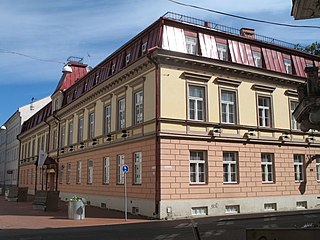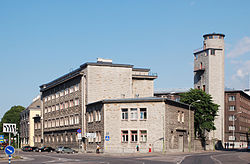Politics in Estonia takes place in a framework of a parliamentary representative democratic republic, whereby the Prime Minister of Estonia is the head of government, and of a multi-party system. Legislative power is vested in the Estonian parliament. Executive power is exercised by the government, which is led by the prime minister. The judiciary is independent of the executive and the legislature. Estonia is a member of United Nations, the European Union, and NATO.

Tallinn is the most populous, primate, and capital city of Estonia. Situated on a bay in north Estonia, on the shore of the Gulf of Finland of the Baltic Sea, Tallinn has a population of 437,811 and administratively lies in the Harju maakond (county). Tallinn is the main financial, industrial, and cultural centre of Estonia. It is located 187 km (116 mi) northwest of the country's second largest city Tartu, however only 80 km (50 mi) south of Helsinki, Finland, also 320 km (200 mi) west of Saint Petersburg, Russia, 300 km (190 mi) north of Riga, Latvia, and 380 km (240 mi) east of Stockholm, Sweden. From the 13th century until the first half of the 20th century, Tallinn was known in most of the world by variants of its other historical name Reval.

Tallinn Airport or Lennart Meri Tallinn Airport is the largest airport in Estonia as well as the only airport offering international services, and serves as a hub for the national airline Nordica, as well as the secondary hub for AirBaltic, cargo airline Airest and LOT Polish Airlines. It was also the home base of the now defunct national airline Estonian Air. Tallinn Airport is open to both domestic and international flights. It is located 2.7 nautical miles southeast of the centre of Tallinn on the eastern shore of Lake Ülemiste. It was formerly known as Ülemiste Airport.

Tartu is the second-largest city in Estonia after the political and financial capital, Tallinn. It is 186 kilometres southeast of Tallinn and 245 kilometres northeast of Riga, the capital of Latvia. Tartu lies on the Emajõgi river, which connects the two largest lakes in Estonia, Lake Võrtsjärv and Lake Peipus. The city is served by Tartu Airport.

Narva is a municipality and city in Estonia. It is located in Ida-Viru County, at the eastern extreme point of Estonia, at the Russian border, on the Narva River which drains Lake Peipus. The city of Narva is the country's third largest after Tallinn and Tartu.

Mart Laar is an Estonian politician and historian. He served as the Prime Minister of Estonia from 1992 to 1994 and from 1999 to 2002. Laar is credited with having helped bring about Estonia's rapid economic development during the 1990s. He is a member of the centre-right Isamaa party.

Kehra is a town in Anija Parish, Harju County, Estonia, most known for its pulp and paper mill.

The Holocaust in Estonia refers to the Nazi crimes during the 1941-1944 occupation of Estonia by Nazi Germany.
The Estonian Open Air Museum is a life-sized reconstruction of an 18th-19th century rural/fishing village, which includes church, tavern, schoolhouse, several mills, a fire station, twelve farmyards and net sheds. Furthermore, it includes a recently opened 20th century Soviet kolkhoz apartment building, and a prefabricated modern wooden house from 2019. The site spans 72 hectares of land and along with the farmyards, old public buildings are arranged singularly and in groups in a way that represents an overview of Estonian vernacular architecture of the past two centuries from across Estonia.

The New Bedford Fire Museum is a local history museum at 51 Bedford Street in New Bedford, Massachusetts, United States. It is located in the 1867 Fire Station No. 4, the city's oldest surviving fire station. The building was listed on the National Register of Historic Places in 1975. The museum is open between July 4 and Labor Day. It houses a collection of firefighting equipment and memorabilia related to the history of firefighting in the city.

Fire museums, also known as firefighting museums are prevalent throughout the world.

The Estonian Maritime Museum is located in the Fat Margaret tower in the old town of Tallinn. The museum presents the history of ships and navigation in Estonia and related to Estonia. Other parts of the Maritime Museum are the mine museum and the Seaplane Harbour museum where ships are presented. The museum claims to be one of the largest museums in Estonia and the most popular.

Estonia, officially the Republic of Estonia, is a country in Northern Europe. It is bordered to the north by the Gulf of Finland across from Finland, to the west by the Baltic Sea across from Sweden, to the south by Latvia, and to the east by Lake Peipus and Russia. The territory of Estonia consists of the mainland, the larger islands of Saaremaa and Hiiumaa, and over 2,200 other islands and islets on the eastern coast of the Baltic Sea, covering a total area of 45,339 square kilometres (17,505 sq mi). The capital city Tallinn and Tartu are the two largest urban areas of the country. The Estonian language is the autochthonous and the official language of Estonia; it is the first language of the majority of its population, as well as the world's second most spoken Finnic language.

The Estonian Sports and Olympic Museum, founded in 1963 and modernized in 2020, is the largest sports museum in the Baltic states. The museum is located on Rüütli street in Tartu, Estonia. Before 2016, Estonian Sports and Olympic Museum was named Estonian Sports Museum.
The 2015 Meistriliiga was the 25th season of the Meistriliiga, the first level in the Estonian football system. The season started on 6 March 2015 and the final matchday took place on 7 November. Levadia, the defending champions, finished runner-up behind Flora, who won their tenth title.

The Estonian Museum of Natural History is the Estonian national museum for natural history. It is situated in Tallinn's Old Town.
Estonia participated in the Eurovision Song Contest 2016 with the song "Play" written by Fred Krieger, Stig Rästa and Vallo Kikas. The song was performed by Jüri Pootsmann. The Estonian broadcaster Eesti Rahvusringhääling (ERR) organised the national final Eesti Laul 2016 in order to select the Estonian entry for the 2016 contest in Stockholm, Sweden. The national final consisted of three shows: two semi-finals and a final. Ten songs competed in each semi-final and the top five from each semi-final as determined by a jury panel and public vote qualified to the final. In the final, the winner was selected over two rounds of voting. In the first round, a jury panel and a public vote selected the top three to qualify to the superfinal. In the superfinal, "Play" performed by Jüri Pootsmann was selected as the winner entirely by a public vote.

Chocolala OÜ is an Estonian confectionery company specialized in luxury handmade chocolate and small-batch, bean-to-bar products.















